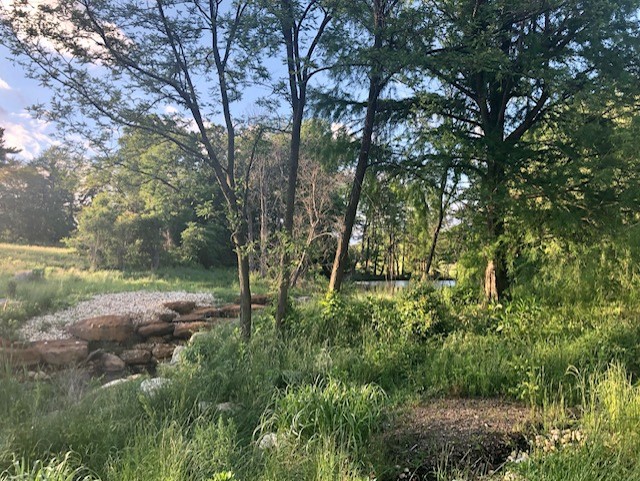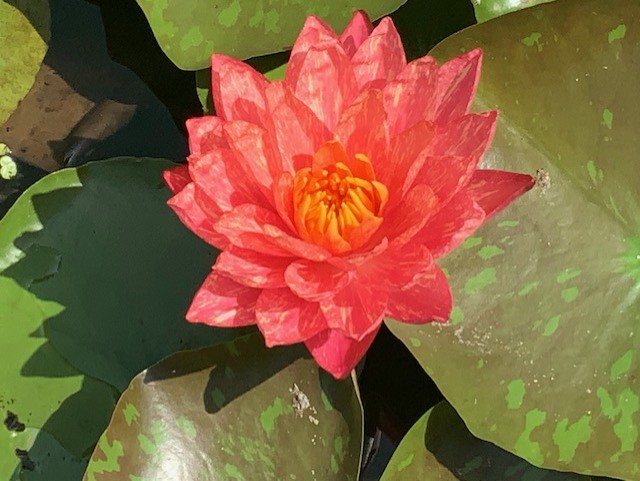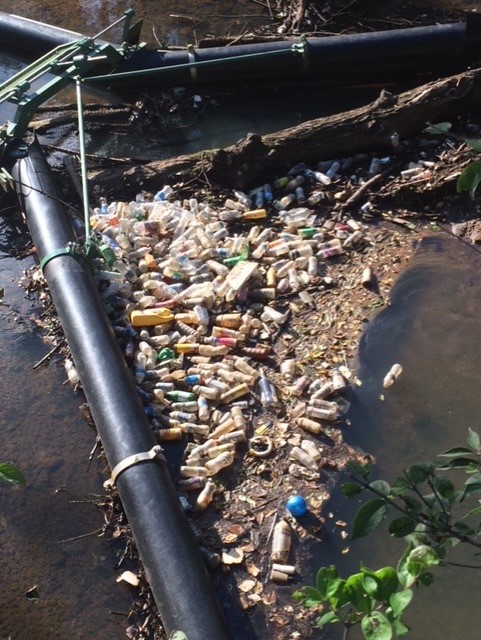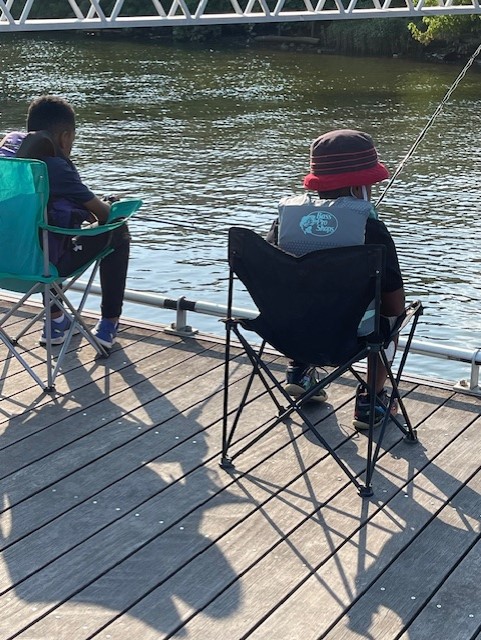THE LEAFLET
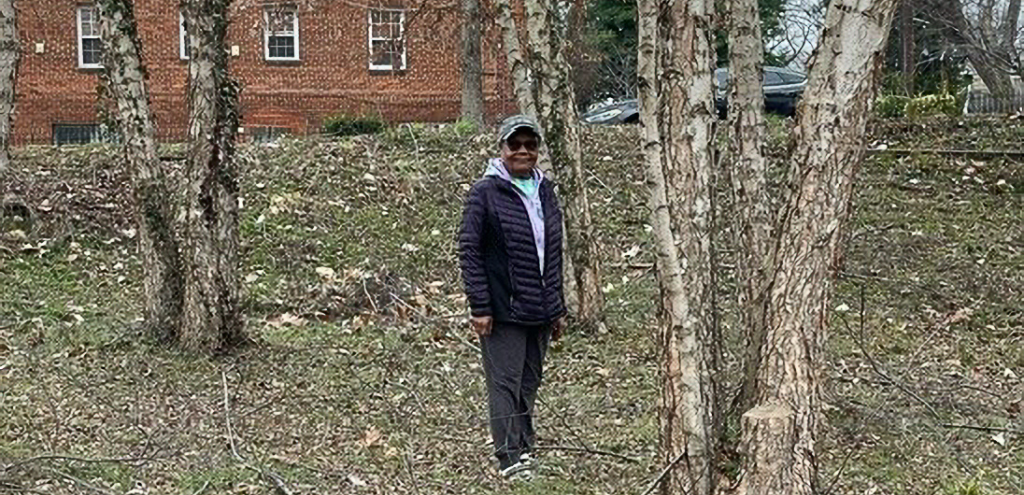
Amplifying Community Voices
As we continue to celebrate Black History Month, we want to use this time to uplift and amplify the voices of those making a difference in our community. Today we’re highlighting Zandra Chestnut, a DC native and avid community activist. Read on to learn about Zandra and the amazing work that she’s been doing across our city!
Casey Trees (CT): Hi Zandra, thank you so much for speaking with us today! We know you like to stay busy, that being said, what organizations or projects are you currently involved in?
Zandra Chestnut (ZC): So, on the top of my list would be the Friends of the National Arboretum. I’ve been on that board for several years and because their whole thing is about trees, it’s one of my favorite places! I was also chair of the Friends of Kenilworth Aquatic Gardens about 2 or 3 years ago, which is another one of my favorites. I’m also a member of the community emergency response team, which is part of our emergency response for the District of Columbia.
I’m a co-founder of the Green Urban Arts Collective, which is a group of artists in Ward 7 and 8 who work with Green art projects, like recycled art. I’m also a Watershed Steward Academy graduate, meaning I work with a lot of citizen scientists with water monitoring the Anacostia watershed, monthly. During the spring and summer months, we would monitor the Watts branch leading to the Anacostia River about once a week. We do that up until it gets too cold to do it. And right now, they’re monitoring the Anacostia for salt because of the snow and how they put the retardant down on the roadway. That’s one of my favorites because I get to go out into the wooded part of Watts branch where people don’t normally go, and you get a chance to see what’s going on near the water.
I’m also a pan village member with East of the River Steelband, which is close to my heart. I’ve had several grandkids who have been part of that band. So, we stay busy following and supporting them. And finally, I’m working with the Resilience Hub Community Coalition, which we just recently got a grant to teach environmental literacy in Ward 7 and 8.
Of course, you know, I’m married to Dennis Chestnut [who is equally involved in leading a number of community projects and initiatives]. So, we spread out and go in different directions, but we always end up coming back home.
So, it’s interesting that we have a lot of kids that we work with, including our own – and I’m also an outdoor photographer. So, I incorporate that into everything that I do. Being outdoors and everything that we do with the children is usually outdoors.
(CT): What is your relationship like with the outdoors, and how did that get started?
(ZC): It started when I was a kid. I’m the oldest of eight. So, I grew up with six brothers under me and one baby sister under them. We were outdoors all the time. As a matter of fact, we come from the old school where in the morning you do your chores and then your parents put you outside and you’re out there all day. Then when you come back in, you’ve already had lunch or snacks either from the trees, or bushes, or friends’ houses. But we were outdoors, and we enjoyed the openness of it. Because when you’re 8 or 10 strong in a house, you don’t have a lot of room, so, the outdoors is your friend.
(CT): How long have you lived here in DC?
(ZC): I was born here in 1950, but my dad was in the military. So, at an early age we started traveling and moving around. I spent a few years in Canada, in Argentia, Newfoundland – because he was in the Navy. And then, we got stationed back on the east coast and that put us in the Tidewater area of Portsmouth. Since he was stationed down in Norfolk, I attended high school there in Virginia. After I graduated, I came to DC. Since I had family here who were established, I came here out of high school, with hopes they would help me get a job, which they did.
I graduated that June and came to DC the same month; I was working by July and it’s been the same ever since. I came in under the Mayor Barry Youth Employment Program, believe it or not. I’m one of those people that benefited from Mayor Barry’s youth employment. And then in September of that year, I was hired full time by the Metropolitan Police Department. So, I’ve been working from that point until I retired, about four or five years ago. But yes, Norfolk, Virginia, to Washington, DC to meet my future husband and start my family.
(CT): How would you say that the landscape and the green spaces of DC have changed over time?
(ZC): When I moved into this neighborhood, they had just started getting sidewalks, so they had no interest in trees. But over a series of years and through being involved in the community, we connected with Casey Trees. They were doing a big planting in the community, with volunteers and citizen forestry. So, we became involved, and they were instrumental in helping with some tree plantings.
We helped establish a sidewalk on 42nd street, which had been an improvement to quality of life and safety issues in our community. But with the greenness that plantings brought and community coming together, we were meeting people in our neighborhood that we never even knew, but they were coming out to find out “what is going on here and how can I help?”
We also created a trail connector that was connecting the National Park trail to a DC trail. Before, they had to come off the National Park trail and be in a bare space. But we improved that with walking trails! A lot of volunteers came out to help. I think we had a couple of 100 volunteers out here for that path improvement.
We were planting trees in an area of the neighborhood that was not taken care of because it was overgrown. There were a lot of weeds and I have pictures of students from Maryland University working with Casey trees to plant the first grove of river birch, and they’re so beautiful now. We did this in 2010. So, it is awesome over there now. You just walk through, and you have to stop and appreciate your surroundings because the trees have just enhanced the space and it makes you just enjoy walking through that urban space. I call it an urban forest; I love it out here. I call my space “the best well-kept green space in DC”, even though other people might not agree with that! But because we’re surrounded by DC Parks, National Parks, the Anacostia River, and the Watts branch, I’m feeling pretty lucky as far as resources are concerned.
(CT): What is your inspiration behind your art and what message or impression do you want it to have on people who see it.
Originally, I started doing camera photography because I have a lot of kids and I like to document them. And you know, children are your best subjects! They have so many activities that I would take my camera with me, but I love the outdoors. So, most of my content will be trees and flowers. Those ”boring things” that people are like, “oh God, can you show us something else?” But I love the outdoors, so most of my portfolio is trees and flowers and litter.
What is it about the litter? There’s a human behavior that we have here in our community that allows people to feel comfortable with just throwing their stuff from their hand or their car out the window and then littering. When you ask folks, ‘what is litter?’ They’re thinking about dogs and animals, but they don’t understand the impact of manmade litter. So, years ago, I started walking around the community taking pictures of that litter. I have one where guys are sitting at a bus stop with an empty trash can beside him, but there’s litter all around. We want to let people know that this goes into our water, goes down our sewer, into the drain, into the river. That was my association trying to teach people the importance of not littering because it always winds up in our river.
(CT): Historically, participating in outdoor activities, like camping and hiking, was reserved for White individuals. This has obviously changed, but the disparity of Black and Brown representation in these fields is still quite evident. What needs to be done for POC to reclaim their place in outdoor spaces?
(ZC): Well, I don’t believe the hype because my family has been camping and outdoors forever. I mean, now remember I said I had eight siblings; we could not go to theme parks or any place that required money. We had to do it the old school way, which was camping, being outdoors, and of course, certain places were segregated. So, we had our own little spots and just because we had our own little spots and we’re doing things like that doesn’t mean that we were not participating. It was just that we were working it out so that when we did go places like that, we wouldn’t be threatened.
I went up to Deep Creek Lake about 20 years ago with my family and we were discouraged from camping. We had folks come by in the middle of the night and throw stuff on our car and stuff because we were camped where they didn’t feel we should be camped. I think they’ve got it backwards I, and all my family, all my kids – I’ve got 6 kids, 15 grandkids, 4 great grands. We still camp every year.
We don’t own the big RV’s and those vehicles that let people know that we’re going camping. But we go and we enjoy the outdoors. I used to take my children over to Kenilworth to fly kites because there were no obstacles like utility wires and things like that. But I’ve got loads and loads of experiences and memories captured through photographs.
So that is a misperception and I wish people would stop it. I feel that that idea is just promoting people saying, “we don’t camp.” I love being outdoors. I love my children to experience nature, they love it. And it’s healthy for us and in more ways than one. I’m talking about me and Dennis, we just have a different way of raising our kids to be citizens, that involves being active in your own community.
Thus, first being involved with your children, and when you’re involved with your children, you become involved with other people’s children – because your children are around other children. So, you’re working with young people. And I feel that our strength is our young people because they are our future. I know that’s kind of hokey, but you have to invest in them and if you don’t – then we’re up the creek without a paddle.
I remember when there was an organization called Groundwork Anacostia River. We took the kids and there were young people from high school age up to college. They went on the Metro with their backpacks to Green Belt Park for camping. And I had a couple of grandkids on that trip, but the strange looks that they received on the metro as the 10 kids with backpacks went camping. They camped out in the park for several days; it was amazing because you could see that people were looking and wondering what they were doing with those backpacks? Well, they were going camping! After that trip there was a change in those young people. Inner city youth going backpacking camping overnight in Green Belt Park, and the National Park Service supplied all the equipment. So, that was a young group of folks were some of them never camped before but got the chance and were forever changed.
(CT): Why is restoring the tree canopy important to you?
(ZC): First of all, trees provide so much shade. I love my trees, there’s nothing about trees that is negative except the pollen, and I blame that on the male trees! I have a, a willow oak in the yard behind me. That is so awesome. I just have to go over there and try to draw in some of that energy because it’s obviously been around for a long, long time.
We have a lot of old trees in my neighborhood. We have Fort Mahan, which is three blocks away. Trees provide homes to a lot of birds, which I love. I’ve heard that Fort Mahan has more birds than Roosevelt Island. And I would agree because I sit on my back porch and record the sounds and sometimes it’s a dozen different varieties of birds that get picked up on that recording. I’m always thinking about how blessed I am to have all these trees in my neighborhood now.
We’re living in an urban forest y’all! So, we need as many trees as we can get because without those trees, we wouldn’t be able to breathe. We’re also close to 295. So, we’re getting exhaust fumes and any community that’s around that 295 corridor, needs as many trees as possible. They are crucial because without them, we would be hotter in the summer, and we would be breathing less healthy air. I couldn’t live in an area that didn’t have trees.
(CT): What’s your favorite tree?
You know, I sat around thinking about that because I love so many trees! But I’m going to go with the Saucer Magnolia. I’ve got several of them in my community. With the pink saucer flower, when those blossoms come out, oh my God, they’re so great. They’re so beautiful.
(CT): Is there anything else that you would like to share or promote for our readers?
(ZC): I would just like to challenge our readers to become more involved with Casey trees and other groups that are working to expand the tree canopy. Because once you start working in your community, you could relate to it, and you feel more inclined to improve it and protect it. The earlier you start with your kids to show them how to be respectful of nature, mother earth, other people, and other creatures, then the more likelihood that we’re going to have some peace in this world. People need to be respectful of others, whether it’s an animal or a human, or even a plant.
Just come on out and work in the community. Start there and then everything else will come from that. Because, when you’re taking care of your own house, it just allows you to appreciate others, other people’s purposes. It’s not something that’s very complicated and it started with my mom teaching me the golden rule. Do unto others as you would have them do unto you. And it’s just basic, doesn’t matter what your religion is. It’s just treating people the way you want to be treated and the same thing regarding your environment.
